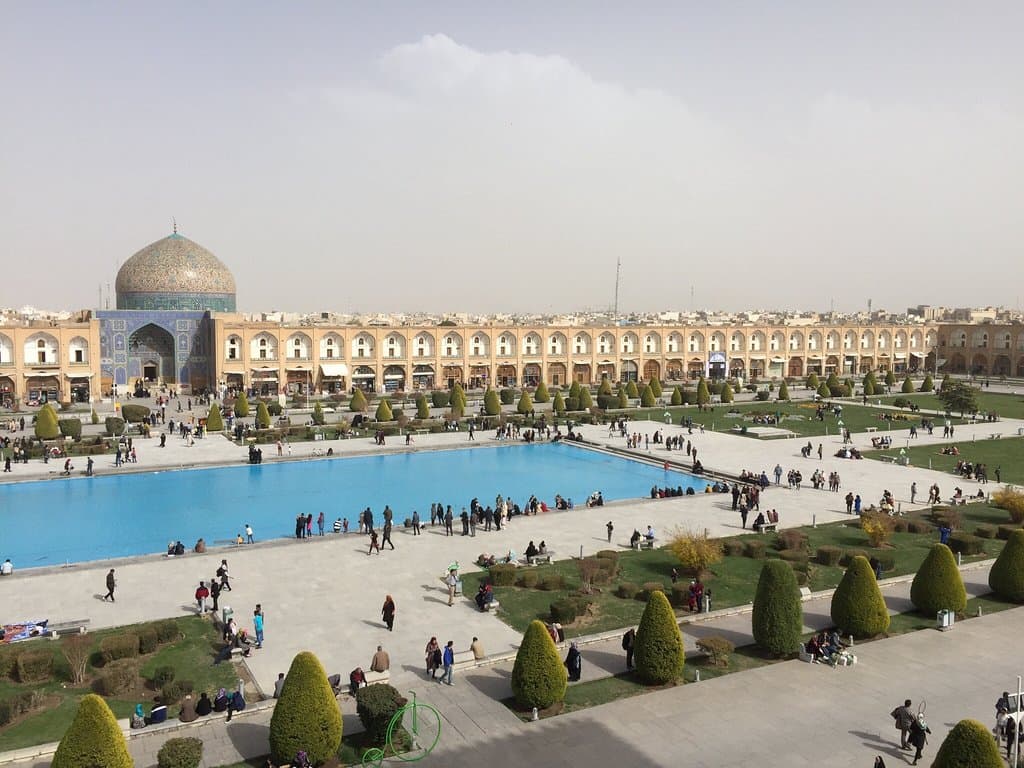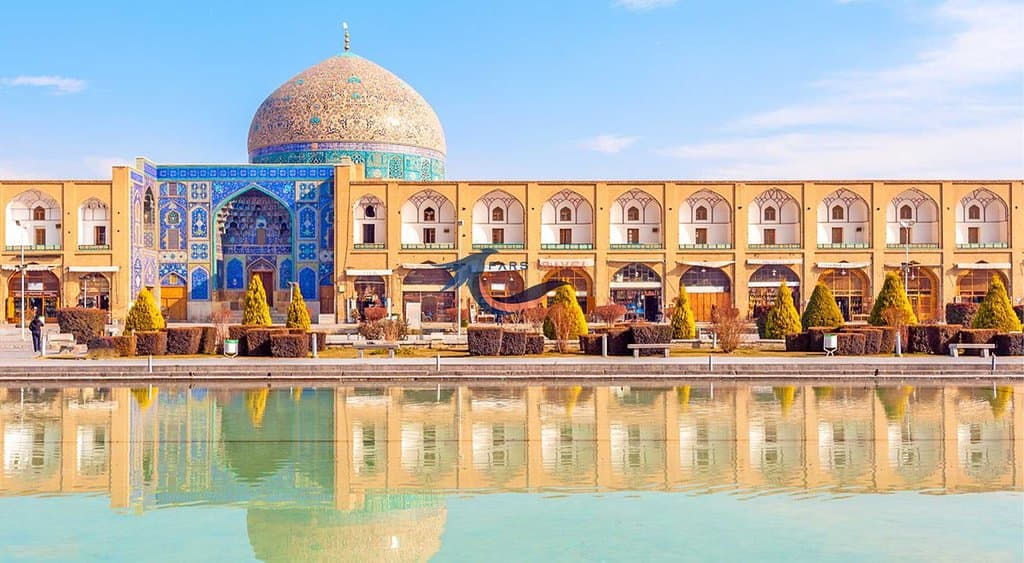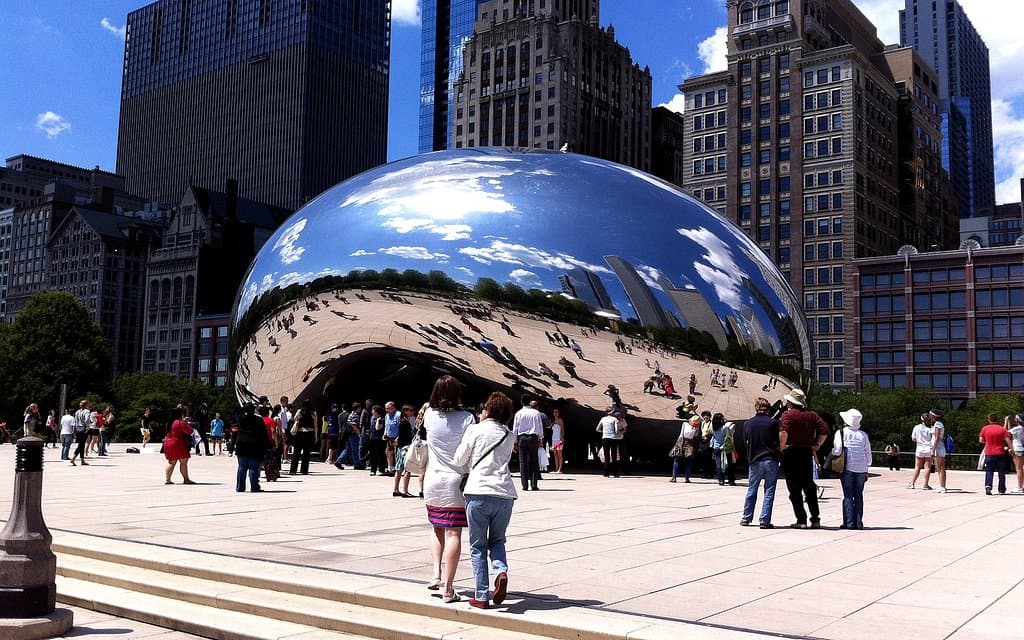
Ali Qapu Palace
A six-story Safavid royal palace with a grand terrace offering panoramic views and an acoustically designed music hall.

Highlights
Must-see attractions

Social
From TikTok & Reddit
Best Time
Golden hour light & sunset

Ali Qapu Palace
Best Time
Golden hour light & sunset

Highlights
Must-see attractions
A six-story Safavid royal palace with a grand terrace offering panoramic views and an acoustically designed music hall.
"An incredible masterpiece offering a truly unique perspective on Naqsh-e Jahan Square."

📸 Best Photo Spots
Capture Naqsh-e Jahan Square from the terrace. The late afternoon light is magical!
👟 Wear Comfy Shoes
Lots of stairs! No elevator, so comfortable footwear is a must for exploring.

Highlights
Discover the most iconic attractions and experiences

The Grand Terrace
Upper floors
Panoramic views of Naqsh-e Jahan Square, perfect for photos and soaking in the atmosphere.

The Music Hall
Top floor
Intricate stucco work with acoustic niches designed for enhanced musical performances.

Spiral Staircase
Entrance
A unique architectural feature leading to the palace's upper levels, building anticipation.
Plans like a pro.
Thinks like you
Planning Your Visit
Timing is Key for Views
Embrace the Climb
Best Times
Insider Tips
from TikTok, Instagram & Reddit
📸 Best Photo Spots
Capture Naqsh-e Jahan Square from the terrace. The late afternoon light is magical!
👟 Wear Comfy Shoes
Lots of stairs! No elevator, so comfortable footwear is a must for exploring.
🎶 Appreciate the Acoustics
Spend time in the Music Hall; the ceiling's design enhances sound for performances.
⏳ Allow ample time
Don't rush your visit. Explore each floor and enjoy the details.
Tips
from all over the internet
📸 Best Photo Spots
Capture Naqsh-e Jahan Square from the terrace. The late afternoon light is magical!
👟 Wear Comfy Shoes
Lots of stairs! No elevator, so comfortable footwear is a must for exploring.
🎶 Appreciate the Acoustics
Spend time in the Music Hall; the ceiling's design enhances sound for performances.
⏳ Allow ample time
Don't rush your visit. Explore each floor and enjoy the details.
What Travellers Say
Reviews Summary
Visitors rave about Ali Qapu Palace as an architectural masterpiece offering breathtaking views of Naqsh-e Jahan Square from its iconic terrace. The Music Hall's unique acoustics and intricate stucco work are consistently highlighted as a major draw, providing a fascinating glimpse into Safavid royal life and artistic ingenuity.
"The Balcony of Isfahan!
Aali Qapu Palace is an incredible masterpiece and offers a truly unique perspective on Naqsh-e Jahan Square. This six-story palace, a former residence of the Safavid kings, is a must-visit. The journey to the top, climbing the spiral staircase, builds anticipation for the spectacular view from the grand terrace. From up there, the entire square unfolds before you in all its glory, making for unforgettable photos.
The true highlight, however, is the Music Hall on the top floor. The intricate stucco work on the ceiling, designed to improve the acoustics for concerts, is simply mesmerizing. The entire palace is a showcase of Persian art and architecture, but the combination of the view and the craftsmanship of the music room makes this a truly special experience.
Important Tips for Your Visit:
* Best Time: Visit in the late afternoon to catch the golden light on the square and a beautiful sunset view.
* The Music Hall: Take your time to appreciate the detailed stucco carvings in the music room. The design is not just beautiful, but also a marvel of engineering.
* The View: Don't miss the panoramic view of Sheikh Lotfollah Mosque and Imam Mosque from the palace's terrace. It’s the best vantage point for appreciating the square's design.
* Stairs: Be prepared to climb several flights of stairs, as there is no elevator.
Aali Qapu Palace is a historical gem that perfectly combines stunning architecture with a breathtaking view of the city. Highly recommended!"
Sana Farzaneh
"Ali Qapu Palace, Isfahan, An Icon of Safavid Royal Power.
Ali Qapu Palace, located on the western side of Naqsh-e Jahan Square in Isfahan, is a magnificent royal palace built in the early 17th century by Shah Abbas I. Its name means “The Great Gate”, as it served as the ceremonial entrance to the Safavid imperial palaces behind the square. The structure is a symbol of political authority and was used to receive foreign dignitaries and hold official audiences.
The palace stands six stories high and rises to about 48 meters. From its famous elevated terrace, supported by 20 slender wooden columns, rulers could watch polo matches and festivities held in the square below. This veranda remains one of the most iconic images of Safavid architecture.
Inside, the palace is known for its exquisite stucco work, especially in the Music Hall on the upper floor. This room features acoustic niches shaped like vases and instruments, designed not only for decoration but to enhance sound quality for musical performances. The detailed paintings and delicate motifs reflect the artistic sophistication of the Safavid court.
Ali Qapu today stands as a testament to Safavid grandeur, offering visitors a window into the ceremonial life of Persian royalty and the architectural brilliance of 17th-century Isfahan."
Lefteris Stamatelatos
"Ali Qapu Palace is one of the most important historical buildings of Isfahan, which was built during the Safavid period as the seat of government of Shah Abbas I. This palace is located on the west side of Naqsh Jahan square and with a height of 48 meters and 6 floors, it is considered one of the most significant buildings of that period.
The entrance to the palace is through a spiral staircase and each floor has unique decorations. On the upper floors, there is a large porch with 18 wooden columns, which offers a wonderful view of Naqsh Jahan square. The ceiling of this porch is decorated with delicate paintings and mirror decorations.
One of the most important parts of the palace is the music room or sound hall, whose walls are designed with special designs to reflect the sound in the best way. This palace is a unique example of Iran's architecture, art and culture in the Safavid period and is registered in the UNESCO World Heritage List."
shabnam asadi
What People Like
What People Dislike
Frequently Asked Questions
🚇 🗺️ Getting There
Ali Qapu Palace is located on the western side of Naqsh-e Jahan Square in Isfahan. You can easily reach it by walking within the square. Taxis and ride-sharing apps are readily available to get you to the square itself.
While there isn't direct public transport to the palace itself, Isfahan has a bus system that can take you near Naqsh-e Jahan Square. From there, it's a short walk.
Walking is the best way to experience the grandeur of Naqsh-e Jahan Square and visit Ali Qapu Palace. Consider a horse-drawn carriage ride around the square for a different perspective.
Driving directly to Ali Qapu Palace is not possible as it's located within the pedestrian-only Naqsh-e Jahan Square. You'll need to park nearby and walk.
Yes, Ali Qapu Palace is situated opposite Sheikh Lotfollah Mosque and near Imam Mosque, all within the magnificent Naqsh-e Jahan Square.
🎫 🎫 Tickets & Entry
Admission fees for Ali Qapu Palace are generally affordable. It's best to check the current prices upon arrival, as they can vary.
The palace is typically open during daylight hours. It's advisable to check the most up-to-date opening times before your visit, as they can change seasonally.
Advance booking is usually not required for Ali Qapu Palace. Tickets can typically be purchased at the entrance.
Information on combined tickets can be limited. It's usually best to purchase tickets for Ali Qapu Palace separately at the site.
Photography is generally allowed inside Ali Qapu Palace, but it's always good practice to be respectful and avoid flash photography in sensitive areas.
🎫 🧭 Onsite Experience
Visiting in the late afternoon is highly recommended to experience the golden hour light and catch a beautiful sunset over Naqsh-e Jahan Square.
Allocate at least 1-2 hours to fully explore the palace, climb the stairs, and enjoy the views from the terrace and the music hall.
The main attractions include the grand terrace with its panoramic views, the intricately decorated Music Hall with its acoustic design, and the detailed artwork throughout the palace.
Due to the spiral staircase and multiple levels, Ali Qapu Palace is not easily accessible for visitors with significant mobility issues. There is no elevator.
The Music Hall features acoustic niches shaped like vases and instruments. This design was ingeniously crafted to absorb echoes and ensure clear sound for musical performances.
📸 📸 Photography
The terrace offers stunning panoramic views of Naqsh-e Jahan Square, especially during golden hour. The intricate stucco work in the Music Hall is also a photographer's dream.
Yes, the terrace provides excellent vantage points for photographing Naqsh-e Jahan Square, including views of Sheikh Lotfollah Mosque and Imam Mosque.
Absolutely! Focus on the detailed stucco carvings in the Music Hall, the delicate paintings, and the overall architectural symmetry of the palace.
Late afternoon is ideal for photography due to the soft, warm light that enhances the colors and textures of the palace and the square.
Tripods might be restricted in certain areas or during peak times. It's best to check on-site regulations. Handheld shots are usually fine.
For Different Travelers
Tailored advice for your travel style
👨👩👧 Families with Kids
Consider visiting during less crowded times if possible to allow children to explore at their own pace. Pack snacks and water, as amenities inside the palace are limited. The surrounding Naqsh-e Jahan Square offers plenty of open space for kids to run around before or after your palace visit.
📸 Photography Enthusiasts
Don't miss the chance to photograph the intricate stucco work in the Music Hall. The unique acoustic niches offer fascinating patterns and textures that make for compelling close-up shots. Experiment with different angles and lighting to capture the essence of this historical gem. Remember to be respectful of other visitors and any on-site photography regulations.
🏛️ History Buffs
Pay close attention to the details that signify Safavid power and artistic sophistication – from the grand terrace used for public spectacles to the acoustically engineered Music Hall. Understanding its function as a "Great Gate" and its connection to the surrounding monumental architecture of Naqsh-e Jahan Square enriches the visitor experience.
Deep Dives
In-depth insights and expert knowledge
The Architectural Marvel of Ali Qapu
The most iconic feature is the elevated terrace, supported by 20 slender wooden columns. This veranda offered rulers a prime spot to observe polo matches, military parades, and festivities in Naqsh-e Jahan Square below. The design of the terrace itself, with its ornate ceiling, is a testament to the era's craftsmanship.
Beyond its grandeur, Ali Qapu is celebrated for its innovative design, particularly the Music Hall on the upper floors. This space features specialized acoustic niches, ingeniously shaped like vases and musical instruments, designed to enhance sound quality and absorb echoes, ensuring perfect acoustics for royal performances.
A Glimpse into Safavid Royal Life
The palace's interior design speaks volumes about the Safavid rulers' appreciation for art and culture. The exquisite stucco work, detailed paintings, and delicate motifs found throughout the palace were not merely decorative but served to impress visitors and reflect the refined tastes of the court. The Music Hall, in particular, highlights the importance of arts and entertainment in royal life.
Today, Ali Qapu stands as a tangible link to this glorious past. Visitors can almost feel the echoes of royal gatherings and imagine the spectacles that once unfolded in the square below. It offers a unique window into the ceremonial practices and the artistic achievements of 17th-century Persia.



Social
from TikTok, Instagram & Reddit